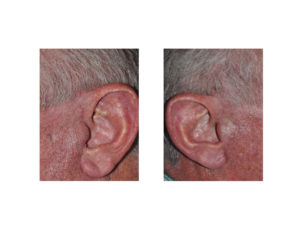According to annual statistics from the American Society of Plastic Surgeons over 100,000 facelift procedures were performed in the U.S. last year. Roughy 10% of them were done in men. While many of the reasons for having a facelift and the surgical techniques used to perform it are not gender specific, there are some distinct differences between men and women in the surgery.
In the February 2017 issue of the journal of Plastic and Reconstructive Surgery, a paper was published on the topic entitled ‘The Modern Male Rhytidectomy: Lessons Learned’. The authors discuss eight (8) key issues that they feel make for a successful male facial rejuvenation result. These include: 1) thicker facial skin 2) stronger flatter brow bones, 3) hairline patterns, 4) less prominent cheekbones, 5) central facial fat atrophy, 6) deeper nasolabial folds and more prominent jowling, 7) loose neck skin and plastysmal banding and 8) higher risks of hematoma. Their recommendations for management of the male facelift patient are based on a twenty year experience with 83 patients.
Their surgical technique consists of the following: 1) tumescent infiltration of low dose epinephrine solution into both sides of the face and neck, 2) concentrated fat injections into the deep malar fat pads and nasolabial folds from inner thigh fat, 3) retrotragal preauricular incision with either hairline or temporal extension with retroauricular hairline extension, 4) thick skin flap elevation to maintain hair follicle survival, 5) anterior submental platysmaplasty, 6) lateral facial SMASectomy and plication, 7) neck and cheek skin flap lateral vector of elevation, and 8) prolonged use of postoperative drains.
Blood pressure management is a major issue in the male facelift patient as many men have either inadequately or undiagnosed high blood pressure. Hypertensive medications were continued up to the day of surgery as well as after surgery. A clonidine patch or 0.2mg were administered the morning of surgery. During surgery either Labetolol or Hydrolazine was given IV as needed. Postoeprative restrictions were placed on strenuous activities for several weeks after surgery.
Using this protocol 83 male facelifts were performed with an average age of 59 years old. One-fourth (25%) of the men had a known history of hypertension. Hematomas occurred in 6% of the patients and were all diagnosed within 24 hours of the surgery. All were treated in the operating room

A successful and natural looking male facelift requires good incisional placement in and around the ears, preservation of as many hair follicles as possible, central face re-volumization and hypertensive management to avoid hematomas.
Dr. Barry Eppley
Indianapolis, Indiana


